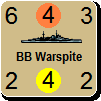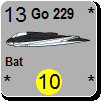warspite1
Posts: 41353
Joined: 2/2/2008
From: England
Status: offline

|
December 1939 (North Sea. Destroyer mine-laying operations and RN submarine warfare)
Posts 119,147 and 162 provided an overview of the audacious – and highly successful - mine-laying operations undertaken by the Kriegsmarine destroyer force that began in October.
Two months later and the Admiralty were still unaware that German destroyers has been operating with impunity right under their noses. Two such operations were planned for December and a number of clues should have led the British to conclude what was going on – although these clues were to be ignored.
We begin this story on the 2nd December with the sailing from Rosyth of the S-class submarine HMS Salmon (Lt-Cdr Edward Bickford). Salmon was ordered to deploy in the North Sea and was two days into her patrol when, around 90 miles south of Egersund (Norway), her crew sighted a U-boat. This was the U-36 starting out on her own patrol and blissfully unaware of the presence of the British boat. Bickford ordered the German boat be closed at full speed and, when the gap had been reduced to 5,000 yards, a full torpedo salvo was fired at seven second intervals. One torpedo hit the German boat, blowing her apart instantly. The Salmon searched for survivors but found only small pieces of wreckage. 40 German sailors were lost.
HMS Salmon was launched in 1933 and was an S-class (Type II) medium submarine. The S-class were designed specifically for patrolling in the North Sea and Mediterranean. More S-class were built for the RN than any other boat class; 62 were constructed between 1931-1945. See next post for further details.

Meanwhile, on the 6th-7th December the Kriegsmarine launched another mine-laying operation – with the destination this time being the Norfolk coast off the town of Cromer. Three destroyers were earmarked for the operation: Erich Giese, Hans Lody and Bernd von Arnim, however the latter was forced to turn back to port shortly after starting out due to engine problems.
Giese and Lody continued on and, after laying their mines, set course for home in the early hours of the 7th. Two British destroyers on patrol – Juno and Jersey - were spotted in the distance and the German destroyers wasted no time in firing a spread of torpedoes from just under 6,000 yards. Just prior to a torpedo hitting Jersey, the lookouts on board Juno spotted dark shapes in the distance. However, once the torpedo hit both commanders made the assumption that this must have come from a submarine.
As the crew of Jersey fought successfully to save their ship, the Juno went off in search of a U-boat that was never there, and the two German destroyers made a hasty getaway. With hindsight it is not easy to understand why they did not press home the attack given that surprise and thus advantage was with them. But in any case, the German destroyers reached home and their minefield would account for two ships (and a third damaged) in the coming days. Jersey, with the aid of her sister, managed to reach port too. 10 officers and crew had died in the attack.
A week later another such operation was launched with the target being the northeast coast off Newcastle. For this attack the Germans gathered together five destroyers; Hermann Kunne, Friedrich Ihn, Erich Steinbrinck, Richard Beitzen and Bruno Heinemann. After laying their mines undetected, the destroyers headed back across the North Sea in the early hours of the 13th where they would be met by Konteradmiral Lutjens and his force of light cruisers off Heligoland. The destroyers parting gifts would in due course claim 11 merchant ships totalling almost 19,000 tons and damage others including the destroyer HMS Kelly which, on the 14th, struck one of the mines while attending a tanker that had been damaged having struck one of the mines herself.
While all this was unfolding off the English coast, further events were taking place in the North Sea. We now head back to the submarine Salmon. On the morning of the 13th while still on patrol she came across the 51,000 ton liner SS Bremen. At the outset of the war Bremen had been on her way to New York but managed to turn around and, successfully evading the RN, she put into the Soviet harbour of Murmansk. She had been holed up there for three months when she was ordered to make a dash for Germany. Unfortunately for the British, when Salmon came across her she was under air escort and Bickford decided not to risk an attack against the liner.
However, later that morning Salmon came across a large number of German warships. These were Lutjen’s cruisers – Koln, Leipzig and Nurnberg – and the five destroyers they were escorting back to Germany from their mine-laying operation. Although the range was over 11,000 yards, this was not a target to be let go. Bickford fired a salvo at eleven second intervals. Explosions were heard but Salmon quickly came under counterattack and Bickford ordered her to dive. Depth charges were fired at her for over an hour before all went quiet and she surfaced to check out the position. However there was nothing to find and, completely out of torpedoes, she returned for home.
What Bickford did not know was that two of his torpedoes had struck home and both the Leipzig and the Nurnberg had been damaged – Leipzig seriously so. Furthermore during the next day, the submarine HMS Ursula (Lt-Cdr Philips), which was patrolling off the German coast, came across the limping Leipzig and her escorts and made ready for an attack.
All torpedoes missed the cruiser, but one hit one of her escorts, the F9. Both Ursula and Leipzig were able to make their escape, unlike the F9 which quickly sank with heavy loss of life (cannot get exact detail).
The light cruiser Leipzig. Although she would survive the attentions of Salmon and Ursula and would be patched up, she was never fully operational again.

The F9. Ten of the ‘F-class’ Flottenbegleiter were built between 1934 and 1938. They were designed as inner escorts for the Deutschland-class but they proved to be something of a disaster. Poor sea boats and with an engine that was simply too unreliable, these vessels were soon relegated to backwater, non-combat duties.

Despite the growing evidence, quite incredibly, the British remained unaware of just what was taking place right under their very noses……
Sources:
The Gathering Storm (Geirr H Haarr)
Chronology of the War at Sea 1939-45 (Jurgen Rohwer)
British Submarines 1938-45 (Osprey)
Kriegsmarine Coastal Forces (Osprey)
 Attachment (3) Attachment (3)
< Message edited by warspite1 -- 8/31/2015 9:07:30 AM >
_____________________________
England expects that every man will do his duty. Horatio Nelson October 1805  |
 Printable Version
Printable Version


























 Wow I had no idea she was that severely damaged and impaired! Curious if any U-Boots were within range to support an escape?
Wow I had no idea she was that severely damaged and impaired! Curious if any U-Boots were within range to support an escape?



 New Messages
New Messages No New Messages
No New Messages Hot Topic w/ New Messages
Hot Topic w/ New Messages Hot Topic w/o New Messages
Hot Topic w/o New Messages Locked w/ New Messages
Locked w/ New Messages Locked w/o New Messages
Locked w/o New Messages Post New Thread
Post New Thread